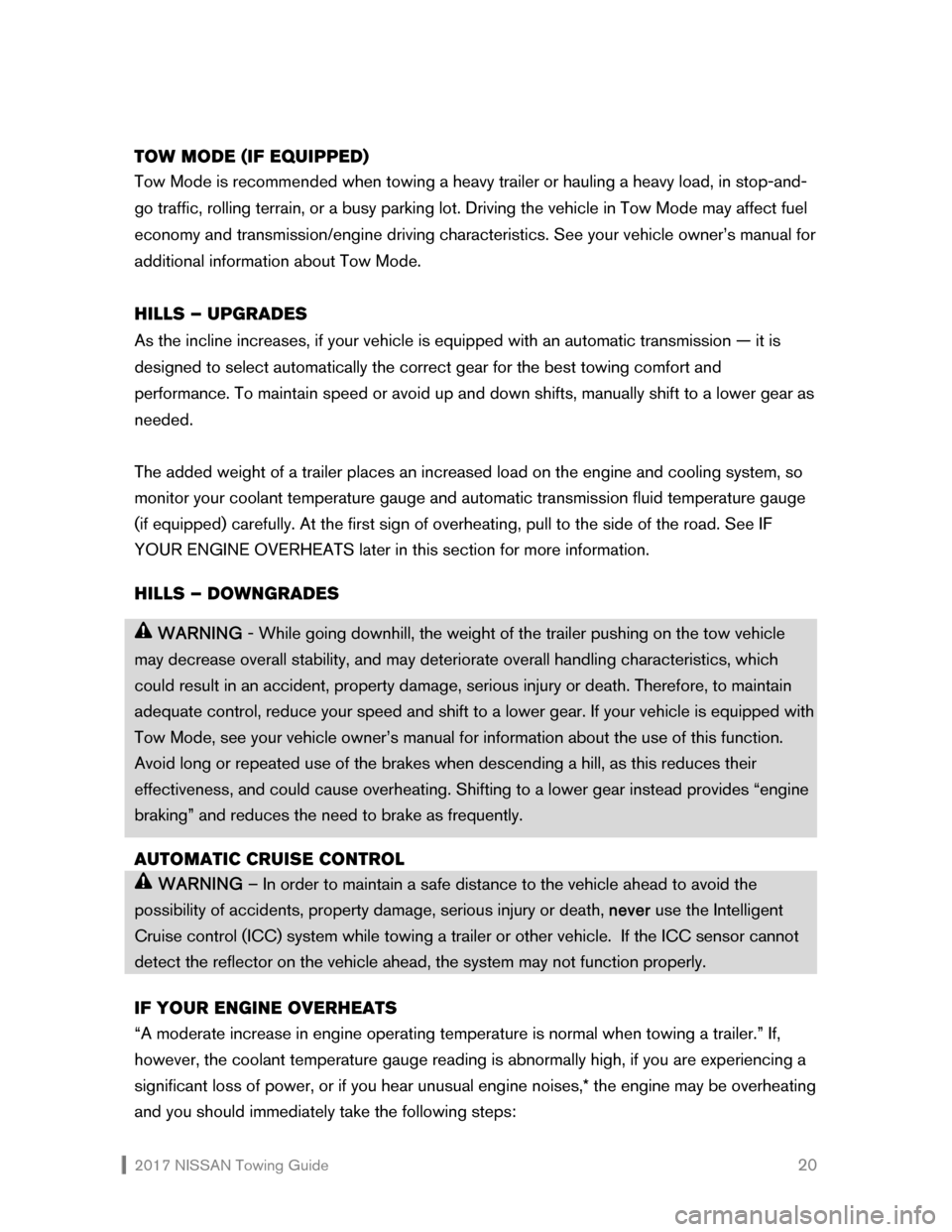Page 21 of 27

2017 NISSAN Towing Guide 20
TOW MODE (IF EQUIPPED)
Tow Mode is recommended when towing a heavy trailer or hauling a heavy load, in stop-and-
go traffic, rolling terrain, or a busy parking lot. Driving the vehicle in Tow Mode may affect fuel
economy and transmission/engine driving characteristics. See your vehicle owner’s manual for
additional information about Tow Mode.
HILLS – UPGRADES
As the incline increases, if your vehicle is equipped with an automatic transmission — it is
designed to select automatically the correct gear for the best towing comfort and
performance. To maintain speed or avoid up and down shifts, manually shift to a lower gear as
needed.
The added weight of a trailer places an increased load on the engine and cooling system, so
monitor your coolant temperature gauge and automatic transmission fluid temperature gauge
(if equipped) carefully. At the first sign of overheating, pull to the side of the road. See IF
YOUR ENGINE OVERHEATS later in this section for more information.
HILLS – DOWNGRADES
WARNING - While going downhill, the weight of the trailer pushing on the tow vehicle
may decrease overall stability, and may deteriorate overall handling characteristics, which
could result in an accident, property damage, serious injury or death. Therefore, to maintain
adequate control, reduce your speed and shift to a lower gear. If your vehicle is equipped with
Tow Mode, see your vehicle owner’s manual for information about the use of this function.
Avoid long or repeated use of the brakes when descending a hill, as this reduces their
effectiveness, and could cause overheating. Shifting to a lower gear instead provides “engine
braking” and reduces the need to brake as frequently.
AUTOMATIC CRUISE CONTROL
WARNING – In order to maintain a safe distance to the vehicle ahead to avoid the
possibility of accidents, property damage, serious injury or death, never use the Intelligent
Cruise control (ICC) system while towing a trailer or other vehicle. If the ICC sensor cannot
detect the reflector on the vehicle ahead, the system may not function properly.
IF YOUR ENGINE OVERHEATS
“A moderate increase in engine operating temperature is normal when towing a trailer.” If,
however, the coolant temperature gauge reading is abnormally high, if you are experiencing a
significant loss of power, or if you hear unusual engine noises,* the engine may be overheating
and you should immediately take the following steps:
Page 23 of 27

2017 NISSAN Towing Guide 22
NOTES – All NISSAN vehicles have an engine protection mode, which helps reduce the
chance of engine damage if the engine coolant reaches a specified temperature. See your
vehicle owner’s manual for details.
1 Maximum Trailer Weight values are calculated assuming a base vehicle with driver and any
options to achieve the rating. Additional passengers, cargo and/or additional optional
equipment will add weight to the vehicle and reduce your vehicle’s maximum towing
capacity and trailer tongue load.
2 Use of a weight-distributing hitch system is required when towing over 5,000 lbs.
3 The Maximum Trailer Weight and Gross Combined Weight ratings for 5th wheel and
gooseneck trailer towing are the same as specified for conventional trailer towing.
4 Most states require a separate braking system on trailers with a loaded weight above a
specific amount. Check local regulations where you plan to tow. A 4 or 7-pin type
connector trailer wire harnesses may be required for use with trailer brakes (available
separately).
Other Recommendations and Information – Towing performance and speed are affected by
vehicle payload, tow weight, road grades, and weather conditions, including high
temperatures. See your vehicle owner’s manual for details.
TOWING GLOSSARY
5TH WHEEL
HITCH Located just forward of the rear axle centerline, this hitch uses a king pin to
serve as the pivot point for the trailer.
BALL MOUNT A bar that holds the hitch ball and is inserted into the hitch receiver. Also
commonly called a drawbar.
BREAKAWAY SWITCH A safety device using a trailer battery that automatically applies the trailer’s
brakes if the trailer accidentally becomes separated from the tow vehicle.
A breakaway switch may be used with both electric or surge trailer brake
systems.
BUMPER HITCH A reinforced bumper designed to accommodate a hitch ball.
ELECTRIC TRAILER
BRAKES When the brakes on a tow vehicle are applied, an electric current is sent to
an actuator, which applies the trailer’s brakes.
ELECTRIC TRAILER
BRAKE CONTROLLER A device that controls the electric trailer brakes.
GOOSENECK HITCH Located just forward of the rear axle centerline, this hitch uses a ball to serve
as the pivot point for the trailer.
Page 24 of 27

2017 NISSAN Towing Guide 23
GROSS AXLE
WEIGHT RATING (GAWR) The maximum amount of weight each vehicle axle (front and rear) is
designed to safely carry.
GROSS COMBINED
WEIGHT RATING (GCWR) The maximum allowable combined weight of the vehicle and trailer,
including passengers and all cargo.
GROSS VEHICLE
WEIGHT RATING (GVWR) The maximum allowable weight of the vehicle, including passengers, cargo,
fuel, hitch, trailer tongue load, and any optional equipment.
KING PIN
LOAD The amount of trailer (5th wheel or gooseneck) weight pressing down on the
tow vehicle hitch.
HITCH BALL
A ball that connects the trailer to the tow vehicle hitch that provides the
means by which the trailer pivots during cornering. Available in a number
of sizes and weight capacities, it must correspond to the trailer coupler
size, and have a sufficient capacity rating for the trailer being pulled.
RECEIVER HITCH A frame- or structure-mounted hitch with a receiver that allows removal of
the ball mount.
SAFETY CHAINS/CABLES Provides an emergency connection between the tow vehicle and the trailer,
should the trailer become disengaged for any reason.
SURGE BRAKES
Hydraulic-type braking system activated by inertia. As the tow vehicle
begins to brake, the trailer pushes against the hitch ball, consequently
activating the trailer brakes.
TRAILER LIGHT CHECK The system allows you to visually check the trailer brake lights as you cycle
through them, controlled by the Intelligent Key.
TRAILER TONGUE/COUPLER The part of the trailer that extends forward to meet the tow vehicle, and
carries the coupler assembly.
TRAILER TONGUE
LOAD
The amount of trailer (conventional) weight pressing down on the tow
vehicle hitch.
WEIGHT-DISTRIBUTING
HITCH SYSTEM Type of hitch system that helps shift the trailer tongue weight to all trailer
tires and the tow vehicle front tires. Strongly recommended when towing
trailers with a Maximum Trailer Weight greater than 5,000 lbs.
WIRING HARNESS Provides an electrical connection linking the tow vehicle’s electrical system
to the trailer’s system.
Page:
< prev 1-8 9-16 17-24